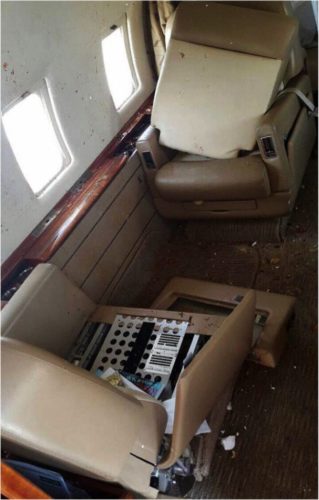A plane flying in the opposite direction underneath an Emirates A380 operating Dubai to Sydney experienced extreme wake turbulence causing the Bombardier (Canadair) Challenger 604 to flip over “three to five times”, before plunging 10,000 feet towards the Arabian Sea. Miraculously, the pilots were able to recover the jet and perform an emergency landing in Muscat, Oman. Multiple passengers were taken to the hospital and one reported serious injuries. The plane was so badly damaged that it had to be written off. The event occurred in January, but was just reported last month by The Aviation Herald. What’s unique (but according to The Aviation Herald is becoming more and more common), is that this event occurred at cruising altitude while the impacted jet was flying at 34,000 feet.
The miraculous recovery was referred to by the Flight Service Bureau as “in the same category as the ‘Miracle on the Hudson’”.
According to information The Aviation Herald received on March 4th 2017 the CL-604 passed 1000 feet below an Airbus A380-800 while enroute over the Arabian Sea, when a short time later (1-2 minutes) the aircraft encountered wake turbulence sending the aircraft in uncontrolled roll turning the aircraft around at least 3 times (possibly even 5 times), both engines flamed out, the Ram Air Turbine could not deploy possibly as result of G-forces and structural stress, the aircraft lost about 10,000 feet until the crew was able to recover the aircraft exercising raw muscle force, restart the engines and divert to Muscat.
The European Aviation Safety Agency (EASA) recently provided an information bulletin warning operators of the increase in cruising altitude wake turbulence encounters:
With the increase of the overall volume of air traffic and enhanced navigation precision, wake turbulence encounters in the en-route phase of flight above 10 000 feet (ft) mean sea level (MSL) have progressively become more frequent in the last few years.
The aim of this SIB is to enhance the awareness of pilots and air traffic controllers of the risks associated with wake turbulence encounters in the en-route phase of flight and provide recommendations with the purpose of mitigating the associated risks.
Full details here.
The responses below are not provided or commissioned by the bank advertiser. Responses have not been reviewed, approved or otherwise endorsed by the bank advertiser. It is not the bank advertiser's responsibility to ensure all posts and/or questions are answered.
